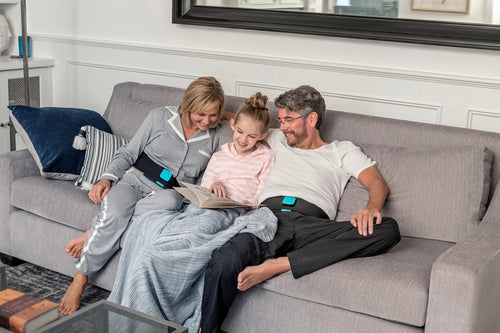Whether it’s in the office, on your commute or at home, how many hours do you spend sat down? If it’s 8-9 hours every day, you’re not alone (even active people can total this much behind a desk). Here are 5 ways to promote good posture to reduce back pain, boost health and tone-up your abs.
Maximise comfort first
Before we look at accessories, here are some office ergonomics to boost your posture and comfort:
Align ears, shoulders and hips
If your ears, shoulders and hips are vertically aligned like a ruler, it means that you’re sitting straight.
Roll back the shoulders
Roll your shoulders backwards and down into a relaxed position. This puffs out the chest which helps straighten the back.
Ground both your feet
Crossing or stretching out your legs can affect your posture. Ensure that both feet are in contact with the floor with the knees slightly lower than the hips. You may need a footrest or to adjust your chair.
Correct your desktop set-up
To avoid leaning and slouching, situate your monitor an arm’s length away with the top of the screen at eyelevel. Your keyboard should enable you to comfortably rest your arms in L shapes while typing.
Challenge your core with an exercise ball
Replacing your desk chair with an exercise ball is an excellent way to improving posture and balance.
Because you’re not sitting on a stable structure your body needs to maintain balance and realign the spine whenever you move, whether that’s reaching for the phone or turning to talk to a work buddy.
Like Slendertone belts, an exercise ball even tones the deep transversus abdominis, which helps firm the stomach muscles and reduces the waistline.
You can even use your exercise ball to squeeze in some quick core circuits during lunches and coffee breaks, including sets of sit-ups, push-ups, planks, roll outs and knee tucks with both feet on the ball.
Keeping balance and stability forces you to constantly engage your core and abs, so using an exercise ball can initially be tough work. We recommend comfortably building up your endurance on the ball.
Within a couple of weeks, your core will be stronger and concentrating those stabilising muscles will become second nature, so don’t give up!
Don’t sit – join the standing desk revolution
If you feel like you spend enough hours seated at home and during your commute, the standing desk (also known as the ‘stand-up desk’ or ‘ergonomic desk’) provides amazing long-term health benefits.
Lose weight
Research by James Levine (who has analysed the benefits of treadmill desks as well) has proven that standing and regularly moving instead of prolonged sitting reduces the risks of weight gain and even obesity.
Simply standing burns additional calories – around 50 per hour, in fact.
Optimise energy
Another study (Pronk, 2011) also found that workers utilising standing desks reported less stress and fatigue.
87% of those test subjects experienced higher levels of energy too. This may explain why intellectual workhorses like Leonardo da Vinci and Winston Churchill favoured the stand-up desk.
Boost health
Research also suggests that sitting down less can reduce your risk of heart disease, colon cancer and type 2 diabetes (The Maastricht Study, 2016).
Like the medicine ball, standing desks take practise and the correct set-up, so build-up your standing hours.
If you’d like to reduce the time you spend sitting down in the office but do not want a standing desk, replace sit-down meetings with walking meetings or stretch your legs when making calls and coffee.
Strengthen your core for perfect posture
A strong and stable core supports the upper body and weight that would otherwise be placed on the spine, which helps reduce the risk of back pain and inflexibility.
Slendertone abs belts utilise innovative electrical muscle stimulation (EMS) technology to strengthen and condition all of your essential abdominal muscles (the rectus and transversus abdominis and the inner and outer obliques).
These electrical signals are similar to those the brain emits to the muscles during exercise or day-to-day activities, like carrying heavy shopping bags of keeping perfect posture while sat behind a desk.
In independent clinical trials, 54% of users reported that they had improved their posture from just 4 weeks of using Slendertone (research conducted by Dr John Porcari at the University of Wisconsin-La Crosse, 2005 and 2009).
This high-tech accessory can also be worn discreetly underneath your regular clothes, making it easy to tone your abs, train the core and concentrate on good posture while you’re working in the office.
Lumo Lift trains the brain to sit straighter
This discreet piece of tech can be clipped onto the inside of your shirt with a magnetic clasp (close to the collarbone) and then activated once you’re comfortably sat straight. This is your ‘target posture’.
Delicate sensors inside the device measure the angle of your body, so whenever you slouch forwards or backwards outside of your set target posture, the Lumo Lift gently vibrates so that you can correct your form.
From 2 weeks, this helps improve your posture by slowly rewiring the neuromuscular patterns in the brain as your target posture edges closer and closer to perfect posture.
This app-controlled posture coach is also a basic fitness tracker which clocks daily steps, distance and calories burned, so that you can be more active every day.

